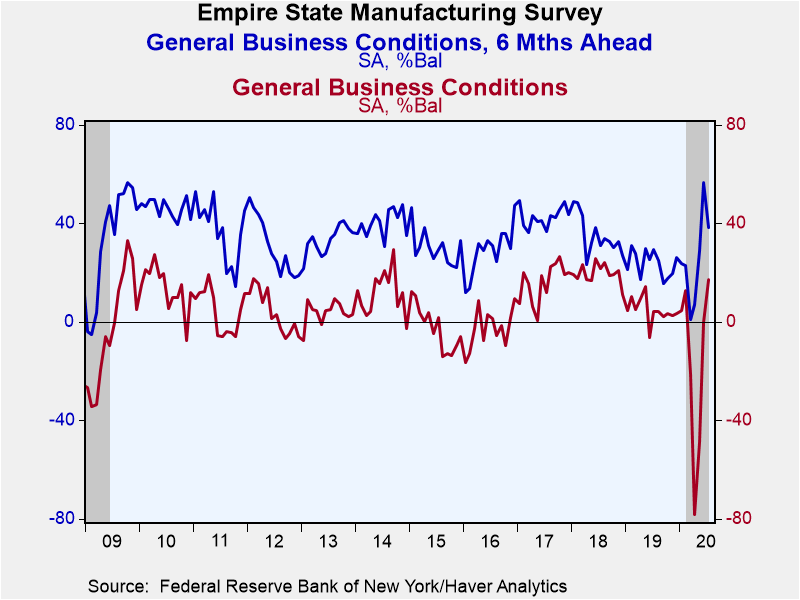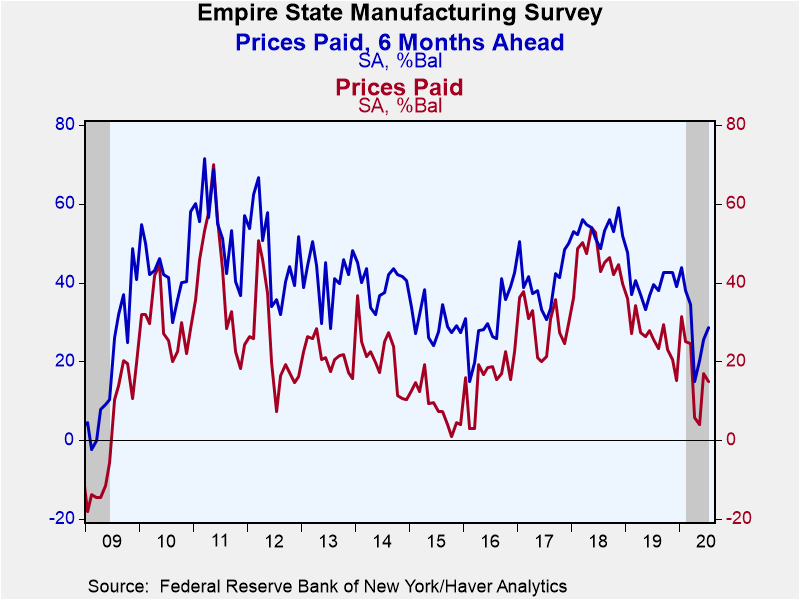 Global| Jul 15 2020
Global| Jul 15 2020Empire State Manufacturing Activity Rose in July
by:Sandy Batten
|in:Economy in Brief
Summary
Economic activity in New York rose in July for the first time in five months. The Empire State Manufacturing Index of General Business Conditions increased 17.2 in July from -0.2 in June, -48.5 in May and a record low -78.2 in April. [...]
Economic activity in New York rose in July for the first time in five months. The Empire State Manufacturing Index of General Business Conditions increased 17.2 in July from -0.2 in June, -48.5 in May and a record low -78.2 in April. The July increase outpaced expectations for an increase to 6.0 in the Action Economics Forecast Survey. The percentage of respondents reporting an increase in business conditions rose to 41.2% in July from 36.1% in June and 14.5% in May. The percentage reporting a decline fell to 24.0% in July from 36.3% in June and 63.1% in May. The overall measure is a diffusion index which is constructed by subtracting the percentage decrease from the percentage increase and measures the breadth of change across the state.
Haver Analytics calculates an ISM-Adjusted Index which mimics the construction of the overall purchasing managers' index. The figure rose further in July to 52.6 from 50.0 in June and 40.5 in May. It was the highest reading since February. The value of 50 for this index separates expansion from contraction.
The subindexes of the report mostly demonstrated improvement. The new orders index rose to 13.9 in July, the first time in positive territory since February, from -0.6 in June. Nearly 40% of respondents reported higher orders in July, up from 35.3% in May, while only 26% reported a decline, the lowest since February, versus 36% last month. The shipments measure jumped to 18.5 in July, its highest level since February, from 3.3. Unfilled orders and delivery times rose modestly while inventories fell.
Employment indicators improved modestly. The number of employees index rose to 0.4 in July, its first positive reading since February, from -3.5. The percentage reporting an increase in employment rose 22.4% from 18.4% in June while the percentage reporting a decline was unchanged at 21.9%. The average workweek measure rose markedly to -2.6 in July from -12.0 in June and -21.6 in May.
The prices paid index slipped to 14.9 in July after having surged to 16.9 in June. The prices received index continued to reflect disinflationary conditions as it fell to -4.5 in July from -0.6 in June. Nearly 10% of respondents reported that their prices received fell in July.
Respondents in July were markedly less optimistic about the next six months than they had been in June. The Expected General Business Conditions index in the Empire State Survey slumped to 38.4 after having surged to 56.5 in June. The June reading had been the highest in a decade. Expectations of both orders and shipments fell meaningfully in July. By contrast, respondents were more optimistic about the outlook for employment and capital expenditures.
The Empire State figures are diffusion indexes, which are calculated by subtracting the percentage of respondents reporting declines from the percentage reporting gains. Their values range from -100 to +100. The data are available in Haver's SURVEYS database. The ISM-adjusted headline index dates back to 2001. The Action Economics Forecasts can be found in Haver's AS1REPNA database.
| Empire State Manufacturing Survey | Jul | Jun | May | Jul'19 | 2019 | 2018 | 2017 |
|---|---|---|---|---|---|---|---|
| General Business Conditions (Diffusion Index, %, SA) | 17.2 | -0.2 | -48.5 | 4.2 | 4.8 | 19.7 | 16.1 |
| General Business Conditions Index (ISM Adjusted, >50=Increasing Activity, SA) | 52.6 | 50.0 | 40.5 | 49.4 | 51.8 | 56.4 | 54.6 |
| New Orders | 13.9 | -0.6 | -42.4 | -0.4 | 3.3 | 16.4 | 14.4 |
| Shipments | 18.5 | 3.3 | -39.0 | 9.1 | 10.5 | 20.3 | 15.8 |
| Unfilled Orders | -0.6 | -12.5 | -20.3 | -5.1 | -6.0 | 3.5 | 1.9 |
| Delivery Time | 2.6 | 1.3 | -4.1 | 4.4 | -0.1 | 9.1 | 6.1 |
| Inventories | -9.7 | -0.6 | -3.4 | -10.9 | -0.9 | 5.9 | 1.5 |
| Number of Employees | 0.4 | -3.5 | -6.1 | -7.9 | 5.4 | 12.3 | 8.0 |
| Average Employee Workweek | -2.6 | -12.0 | -21.6 | 4.2 | 2.3 | 7.8 | 4.6 |
| Prices Paid | 14.9 | 16.9 | 4.1 | 25.5 | 26.3 | 45.8 | 29.0 |
| Prices Received | -4.5 | -0.6 | -7.4 | 5.8 | 10.3 | 19.3 | 11.0 |
| Expectations 6 Months Ahead | 38.4 | 56.5 | 29.1 | 29.3 | 23.9 | 35.2 | 42.6 |
Sandy Batten
AuthorMore in Author Profile »Sandy Batten has more than 30 years of experience analyzing industrial economies and financial markets and a wide range of experience across the financial services sector, government, and academia. Before joining Haver Analytics, Sandy was a Vice President and Senior Economist at Citibank; Senior Credit Market Analyst at CDC Investment Management, Managing Director at Bear Stearns, and Executive Director at JPMorgan. In 2008, Sandy was named the most accurate US forecaster by the National Association for Business Economics. He is a member of the New York Forecasters Club, NABE, and the American Economic Association. Prior to his time in the financial services sector, Sandy was a Research Officer at the Federal Reserve Bank of St. Louis, Senior Staff Economist on the President’s Council of Economic Advisors, Deputy Assistant Secretary for Economic Policy at the US Treasury, and Economist at the International Monetary Fund. Sandy has taught economics at St. Louis University, Denison University, and Muskingun College. He has published numerous peer-reviewed articles in a wide range of academic publications. He has a B.A. in economics from the University of Richmond and a M.A. and Ph.D. in economics from The Ohio State University.










